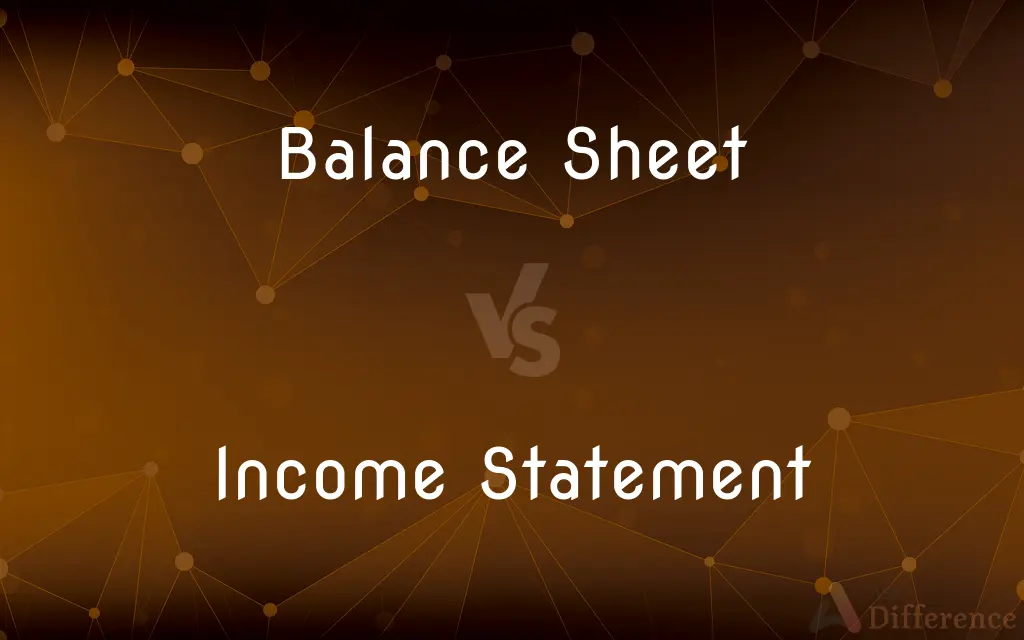Balance Sheet vs. Income Statement — What's the Difference?
By Tayyaba Rehman — Published on November 14, 2023
A Balance Sheet provides a snapshot of a company's assets, liabilities, and equity at a specific point in time. An Income Statement, on the other hand, shows a company's revenues, expenses, and profits or losses over a given period.

Difference Between Balance Sheet and Income Statement
Table of Contents
ADVERTISEMENT
Key Differences
A Balance Sheet is essentially a financial statement that captures the financial position of a company at a particular moment. In contrast, an Income Statement provides a detailed account of how a company performed over a specific duration, indicating its revenues and expenses.
The Balance Sheet categorically lists assets, liabilities, and shareholders' equity. This gives stakeholders insight into what the company owns and owes. On the other hand, the Income Statement emphasizes the company's ability to generate profit, detailing sources of revenue and incurred expenses.
The structure of the Balance Sheet revolves around the accounting equation: Assets = Liabilities + Shareholders' Equity. The Income Statement, however, focuses on the equation: Revenues - Expenses = Net Income.
While the Balance Sheet offers a static view, effectively serving as a financial "snapshot" at year-end or quarter-end, the Income Statement is dynamic, showcasing the flow of transactions, from sales to net profit or loss, over months or years.
The Balance Sheet's primary goal is to ensure that both sides (assets and liabilities plus equity) balance out. In comparison, the Income Statement aims to present a clear picture of financial performance, highlighting efficiency in operations and profitability.
ADVERTISEMENT
Comparison Chart
Purpose
Depicts financial position at a specific date.
Displays financial performance over a period.
Components
Assets, Liabilities, Equity.
Revenues, Expenses, Profit or Loss.
Nature
Static snapshot.
Dynamic, period-based overview.
Equation
Assets = Liabilities + Equity.
Revenues - Expenses = Net Income.
Time Perspective
Point in time (e.g., Dec 31st).
Time span (e.g., Jan 1 to Dec 31).
Compare with Definitions
Balance Sheet
A statement ensuring that both sides (assets and liabilities plus equity) are balanced.
Any discrepancies in the Balance Sheet prompted an immediate audit to rectify errors.
Income Statement
A tool for stakeholders to assess financial performance and earning capacity.
The Income Statement displayed a surge in operational costs, explaining the reduced profits.
Balance Sheet
A financial statement depicting a company's assets, liabilities, and equity at a particular point in time.
The Balance Sheet of XYZ Corp on December 31 showed a significant increase in assets from the previous year.
Income Statement
An indicator of business profitability and operational efficiency.
A consistent increase in revenues on the Income Statement signals a company's expanding market presence.
Balance Sheet
A representation of the accounting equation in financial terms.
A firm's Balance Sheet should always adhere to the formula: Assets = Liabilities + Equity.
Income Statement
A record of earnings and expenditures, leading to net income or loss.
By studying the Income Statement, analysts discerned the reasons behind the firm's unexpected losses.
Balance Sheet
A tool for stakeholders to gauge the net worth of a business.
Through the Balance Sheet, shareholders understood the company's strong equity position.
Income Statement
A financial document outlining a company's revenues and expenses over a set period.
The Income Statement for 2022 revealed a 10% growth in net profit for ABC Inc.
Balance Sheet
A record of what a company owns and owes.
By examining the Balance Sheet, investors can assess the company's debt levels and asset holdings.
Income Statement
A statement that showcases the flow of transactions over a given time.
Quarterly Income Statements help in tracking seasonal fluctuations in sales and expenses.
Common Curiosities
Which statement is crucial for assessing profitability?
The Income Statement is key for evaluating profitability over a specified duration.
Can a Balance Sheet show profit?
No, a Balance Sheet shows assets, liabilities, and equity; profit is determined from the Income Statement.
What does a negative equity on a Balance Sheet signify?
It indicates that liabilities exceed assets, which can be a concern for solvency.
How does an Income Statement differ?
An Income Statement shows the company's revenues, expenses, and net income or loss over a period.
What's the significance of an Income Statement for investors?
It provides insights into a company's earning capacity and operational efficiency.
How often are Income Statements generally published?
Typically, they're published quarterly and annually.
What is a Balance Sheet?
A Balance Sheet provides a snapshot of a company's assets, liabilities, and equity at a specific date.
Why is the Balance Sheet called so?
Because it balances two sides: assets and the sum of liabilities plus equity.
Where do we find interest expenses, on the Balance Sheet or Income Statement?
Interest expenses are found on the Income Statement.
Does the Balance Sheet show cash flows?
No, cash flows are presented in a separate statement called the Statement of Cash Flows.
Which financial statement should a creditor be most interested in?
Creditors often prioritize the Balance Sheet to assess the company's ability to repay debt.
Can the Income Statement help in forecasting?
Yes, by analyzing past Income Statements, trends can be identified for future predictions.
Can a company have a strong Balance Sheet but a weak Income Statement?
Yes, a company might have valuable assets (strong Balance Sheet) but still operate at a loss (weak Income Statement).
Are non-operational activities included in the Balance Sheet?
Yes, it includes all assets and liabilities, operational or not.
How do dividends appear on these statements?
Dividends paid are not on the Income Statement but impact retained earnings on the Balance Sheet and are also presented in the Statement of Cash Flows.
Share Your Discovery

Previous Comparison
U Shaped Valley vs. V Shaped Valley
Next Comparison
Tidal Wave vs. TsunamiAuthor Spotlight
Written by
Tayyaba RehmanTayyaba Rehman is a distinguished writer, currently serving as a primary contributor to askdifference.com. As a researcher in semantics and etymology, Tayyaba's passion for the complexity of languages and their distinctions has found a perfect home on the platform. Tayyaba delves into the intricacies of language, distinguishing between commonly confused words and phrases, thereby providing clarity for readers worldwide.














































